
“Our vision is to be Earth’s most customer centric company; to build a place where people can come to find and discover anything they might want to buy online.”
– Amazon Mission Statement
Amazon’s anticipated entry into Southeast Asia has industry players and watchers on tenterhooks. To understand what can be expected from Amazon’s arrival, we’ll discern the Amazon Playbook, its capabilities, and identify the structural factors that will influence its approach.
1. The Amazon framework
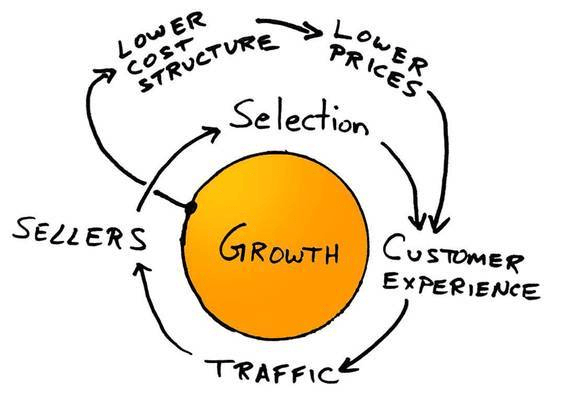
Source: Amazon
Amazon’s overarching intent is to occupy the first contact position in all consumers’ consumption activities. This means that except for dine-in eating and drinking (for now), Amazon intends for all consumer discretionary income to flow through itself.
This can be deduced from its persistent expansion from a single category – books – across most consumer product categories. With the purchase of Whole Foods, that now includes high-end groceries.
Amazon aims to provide superior customer experience with the widest selection, lowest prices, and fastest service times.
Three critical assumptions underpin this strategy.
Assumption 1: Amazon’s marketplace will continue to have the widest selection.
Without its marketplace, Amazon is nothing. All of Amazon’s other services are derived from the need to support Marketplace, e.g. Amazon Web Services first evolving out of Amazon’s internal need for a common set of infrastructure services. Further, Marketplace serves as a vital “internal” customer for Amazon’s services, by providing a significant portion of their respective revenue streams. Additionally, Marketplace serves to continually provide consumers with a superior selection at lower cost. This attracts more visitors.
Assumption 2: Amazon will possess sufficient market power to set prices rather than take them.
Building on the first assumption, by having the dominant market position, Amazon can negotiate supplier discounts superior to those negotiated by its competitors. This widens selection and lowers cost while forcing third-party sellers to lower their prices.
Assumption 3: Amazon will achieve scale across all business units.
Traditionally, the support functions of companies are cost centers. However, Amazon designs its support functions as business products, thus allowing them to be profit centers, while ruthlessly subjecting them to market discipline – thereby disciplining the wider market. Further, these support functions are not restricted to the vertical they currently serve. They support each expansion into a new category. Fulfillment By Amazon, for example, expanded beyond an internal function to a service for third-party sellers.
2. Understanding Amazon’s financial performance
Amazon is a bundle. It is not organized simply by segments but comprises thousands of teams with their respective P&L at different stages of maturity. Some are burning cash to turn a profit in the future, some are losing money, and some are established profit-makers.
The clearest way to cut through the fog is to understand its actual cash flow – the amount of hard cash that it receives in a year. Amazon itself often talks about cash flow, not income. Operating cash flow (OCF) is what you get from subtracting cash paid to suppliers from cash earned from customers. Simply put, it’s how much cold, hard cash was earned from the core business (investment income not included) in a year after paying suppliers, debtors, and taxes.
This chart tells us that Amazon’s cash flow as a percentage of its revenue has remained constant through the years.
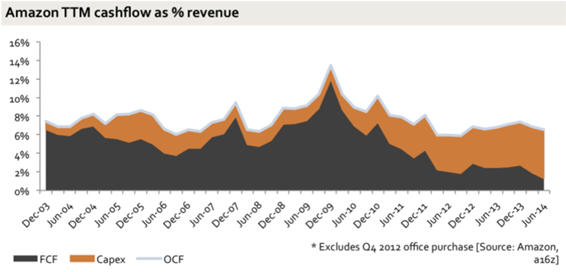 In fact, Amazon is spending its rapidly increasing OCF (in absolute value) on capital expenditure (physical assets).
In fact, Amazon is spending its rapidly increasing OCF (in absolute value) on capital expenditure (physical assets).
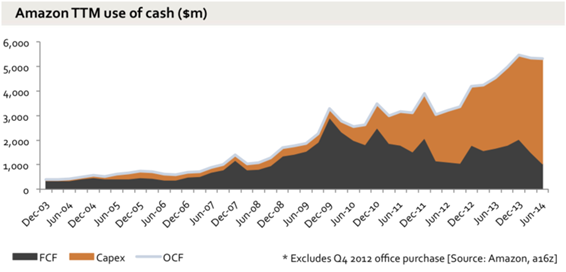
Interestingly, Amazon’s capital expenditure (capex) to sales ratio is increasing rapidly. And while this could be indicative of rising business costs, a quick look at their shipping costs tells us that this may not be the case.
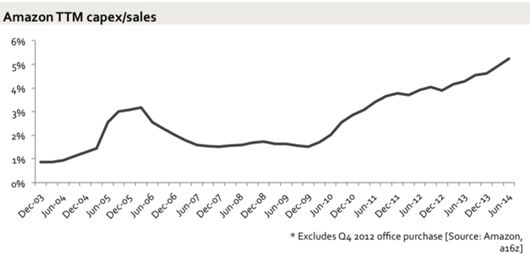
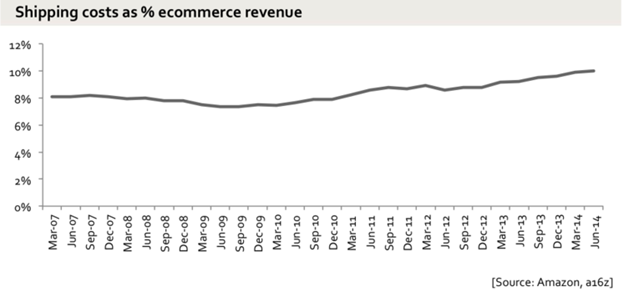
Understanding the reasons for the increased capex is tricky, but based on Amazon’s business we can assume there are four of them. Increased capacity for products, Amazon Web Services, improved proximity to customers by creating more fulfillment centers, and increased cost of warehousing.
While it is hard to be certain if capex is increasing due to rising business costs, it does tell us that instead of realizing profits, Amazon is intent on plowing its massive cash flow back into the business.
3. Understanding Amazon’s offerings
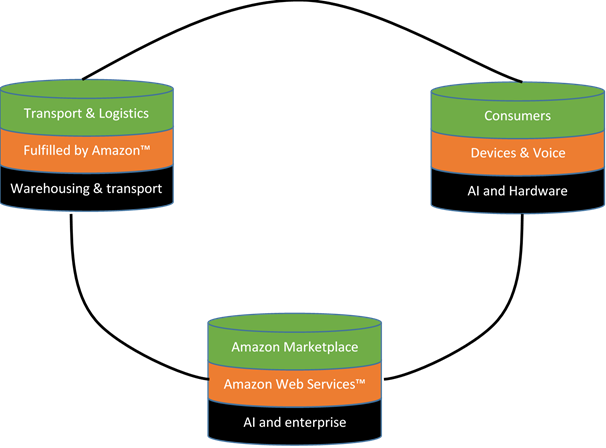
Broadly mapping out the network of Amazon’s offerings and the underpinning “stack” gives a clearer picture of how Amazon maintains profitability, spins out new services, and achieves scale.
In a traditional retail/marketplace model, each stage of the value chain is underpinned by certain operational activities, e.g. transporting and warehousing for logistics needs (black portions of the diagram above). These activities are traditionally outsourced, or if large enough, fulfilled by inhouse departments meant solely for internal needs. Amazon differs from this model in three critical aspects.
Firstly, it has aggregated the operational activities that share the same purpose into business units (orange portions of the diagram).
Secondly, it has spun off those units as business offerings, transforming them from cost centers into profit centers that compete in the market.
Thirdly, it is intent on being part of every touchpoint between consumers and their purchases.
This results in business units that are forced to maintain profitability and productivity by using the market as the benchmark. More importantly, these services have an existing internal customer that can assure them of their revenue. For example, 40 percent of Amazon’s sales (on a unit basis) are sold by third-party merchants with most using Fulfillment by Amazon. This means their goods are stored in Amazon’s fulfillment centers. Increasing the return to scale for Amazon’s fulfillment centers, the value of Prime, and deepening Amazon’s moat.
Ecommerce and retail
Amazon’s retail marketplace resembles a stock exchange where two million registered merchants use algorithms to undercut their competitors. Increasingly, manufacturers are going through Amazon and its Marketplace to reach consumers.
Further, it has launched private-label goods – Amazon Basics – in home essentials, apparel, and consumer packaged goods. Amazon Basics reduces the need for brand development by building on existing Amazon brand recognition. And it takes advantage of proprietary data to know which products will create higher margins before deciding to roll them out.
It has also begun its assault on the brick-and-mortar sector with the launch of Amazon Go, Amazon Fresh, and Amazon Books, all of which combine the latest technology with Amazon data to deliver a richer shopping experience. Amazon Books, for instance, stocks less books in its physical stores than its traditional competitors as it uses Amazon’s data to decide which books are more likely to sell.
Amazon Prime ties these offerings together as a bundle that combines discounts and free shipping for goods and content purchased through Amazon. While it is not intuitively clear why Amazon Video is part of this bundle, entertainment content is produced at high fixed cost but no marginal cost beyond bandwidth, making it an affordable way to entice consumers to become members. Hence, it is a product that can take advantage of economies of scale while drawing people to switch increasing proportions of their consumer spending to Amazon.
AI and voice

Amazon Echo Dot. Photo credit: Guillermo Fernandes.
The Alexa Voice Service, which applies AI to natural language processing (NLP), is the most visible part of Amazon’s AI efforts. The Amazon Echo – a “smart speaker” featuring Alexa – has shipped an estimated 8 million units, with over 10,000 apps for it in Amazon’s app store. It unlocks a new distribution channel – vocal commerce – that allows even easier purchasing of goods.
But Amazon has no desire to make its bet solely on hardware. Instead, it aims to be the cloud-based software of choice that powers everything from car dashboards to wearables. The Echo is not just a new distribution channel but a means of collecting data and training Amazon’s AI.
Amazon Web Services
AWS is now Amazon’s largest source of revenue after its core business, posting US$12.2 billion in sales in 2016 and more than US$3 billion in profit. AWS’s genesis was a result of Amazon overhauling its own internal cloud capacity as its internal teams had no common infrastructure services and had to build their own resources for each project. AWS allows startups to migrate from expensive server hardware and software, which is fixed cost, to the cloud, which represents variable cost based on usage.
In light of the worldwide DDoS attacks as well as emerging AI capabilities, AWS is beefing up its cybersecurity offerings and has begun selling AI-as-a-service under its banner. Its goal is to serve big and small-time developers who want AI without the upfront costs or hassle. Amazon AI unveiled offerings that will work like an API and allow any developer to access Lex (the NLP inside Alexa), Amazon Polly (speech synthesis), and Amazon Rekognition (image analysis).
Transportation and Logistics

Amazon Air Drone
Cheap and fast shipping is a key part of Amazon’s value proposition and as its warehouses grow to meet increasing demand, Amazon is intent on maintaining its margins. In 2012, it purchased Kiva Systems – a warehouse robotics maker – and it now has 45,000 robots in its fleet, growing at 15,000 per year.
It has also grown its fulfilment center coverage, with 44 percent of Americans living within 30km of an Amazon warehouse, compared to just 7 percent in 2012. To achieve independence from incumbent networks, it has also begun building its own delivery infrastructure; developing a US$1.5 billion air freight center in Kentucky and leasing 40 Prime Air cargo jets.
Media and publishing
To increase the value of its Prime memberships, Amazon has included Prime Video into the bundle of benefits. Jeff Bezos has publicly explained the flywheel effect of Prime Video. By providing premium streaming, users are more likely to renew their memberships, leading to more purchases and then more Prime memberships and ecommerce sales.
Amazon has gone beyond distributing content to producing original content. Its shows have won three Oscars, and Amazon is expected to spend US$4.5 billion on content in 2017. This content extends beyond TV shows to sports such as the NFL and esports, where it purchased Twitch (a video game broadcast site) for US$970 million.
Beyond enhancing the value of Prime memberships, it also provides Amazon with a means of selling ads. It has implemented a programmatic ad product that generated over US$1 billion in online ad revenue in 2016.
4. What can Southeast Asia expect?
Amazon’s entry into Southeast Asia will be significantly more complex than its entry into other markets such as the US or Europe. The region comprises ten comparatively smaller markets rather than the single, larger markets that Amazon is used to operating in. One illustration of this is the inconsistency in customs regulations. In Singapore, goods valued at less than S$400 are not subject to duty, but the Malaysian limit is RM500 (approximately S$140). For a S$100 dress purchased from an Southeast Asian country by a Thai, Indonesian, Vietnamese, or Filipino buyer, an additional third of the price will have to be paid in duties.
Four primary factors underpin the growth and adoption of Amazon’s three “pillars” – Amazon Prime, Marketplace and AWS – across the region. These are internet penetration, consumer payments, transport and warehousing capacity, and cloud computing readiness.
Internet penetration
The average level of internet penetration in Southeast Asia is 53 percent compared to the average of 88.5 percent in the US.
A study by Hootsuite and We Are Social breaks it down by country.
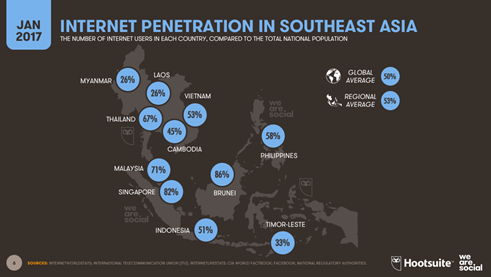
Interestingly, mobile broadband penetration serves to compensate for this gap, and suggests that Amazon may need to further localize its app and web-mobile site to a mobile-first approach.
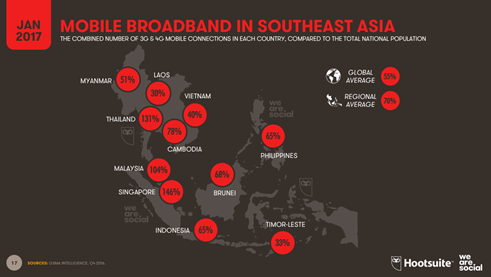
Payment methods
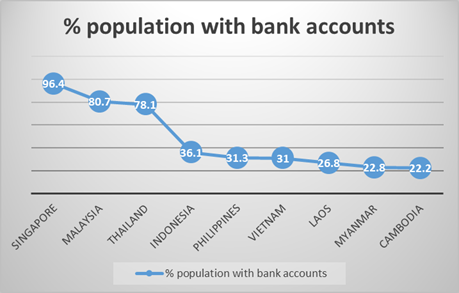
In comparison to the US – where only 7 percent of the population are unbanked – 73 percent of Southeast Asia’s population is unbanked. Data from the World Bank’s Financial Inclusion Index tells us that Singapore, Malaysia and Thailand are the most likely to adopt epayment due to higher banking penetration rates.
However, cash on delivery remains the dominant mode of payment for ecommerce. With the exception of Singapore, it’s preferred in countries like Indonesia, Thailand, and the Philippines where it makes up 50 to 70 percent of orders. Incumbent ecommerce players such as Lazada have had to incorporate cash payments and accompanying procedures such as ensuring customers have cash on hand before making a delivery.
Transportation and warehousing capacity
Southeast Asia’s geography poses inherent challenges to the development of a good logistics network. For example, the Philippines and Indonesia are archipelagos with 7,107 and 13,466 islands respectively.
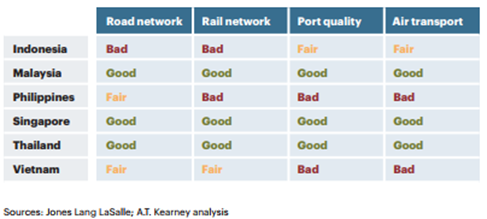
A 2015 study by A.T. Kearney and Jones Lang LaSalle highlights the urgent need for transport networks to improve. Further, it recognizes that outside of Singapore and Thailand, warehouse capacity has not kept pace with economic growth. Lazada has pledged to double its warehouse capacity to meet demand.
Cloud computing readiness
The readiness of Southeast Asian markets to adopt and support cloud computing will be a deciding factor in the success of AWS. While cloud computing allows data centers to be sited overseas, there has been a growth in the number of localized data centers to improve latency and provide data localization. For example, Google Cloud has recently opened an additional data center in Singapore.
The need for data localization can be complicated by the existing policy regime. For example, Singapore and Malaysia do not require in-country data localization, but Indonesia has begun tightening these laws.
This means that AWS will not be able to use data centers that it has built offshore and needs to invest in data centers within the borders of the target market. This hampers the returns to scale it can achieve for existing data centers. At the same time, it needs to find ways to achieve returns to scale for its new data centers. Additionally, AWS becomes exposed to local challenges that it may not have had to deal with in established locales such as power grid stability or policy compliance costs.
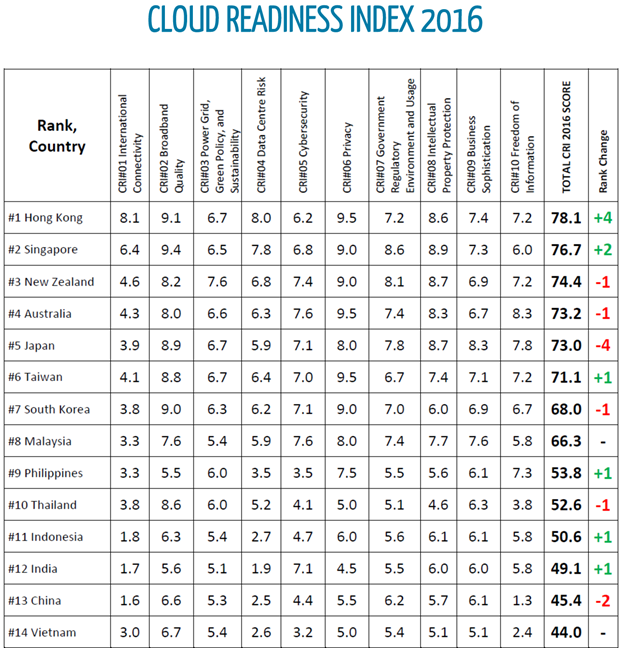
Source: Asia Cloud Computing Association
While Singapore and Malaysia lead the pack in cloud computing readiness in Southeast Asia, there is a clear gap (12.5 points) between Malaysia and the rest of the countries ranked below it. This is a worrying sign as it means that AWS may face an uphill battle in educating businesses on the benefits of cloud computing.
Malaysia, Singapore, and Thailand ready for Marketplace and Amazon Prime
A review of how Southeast Asian countries score against the criteria above shows that Thailand, Malaysia, and Singapore serve as the best starting points for Marketplace and Amazon Prime given the high degree of internet penetration, number of bank account holders, and developed transport networks. Further, entry into Malaysia and Thailand will provide access to the rest of contiguous Southeast Asia without having to go through the added hassle of air or sea shipping.
However, as Amazon Prime is a bundle that works together with free shipping and content (Amazon Video), it will face a roadblock in localizing its benefits. Amazon Video, for example, is in English, but only 62.57 percent of Malaysians and 27.16 percent of Thailand’s population are English-speaking. Additionally, this does not take into account market demand for US serials.
Malaysia and Singapore ready for AWS
Two factors work strongly in Malaysia and Singapore’s favor: stable macro-environment (power infrastructure, economy, and labor) and government regulations that allow the free flow of data. Further, these countries can readily serve as jump-off points into more welcoming markets in Northeast Asia, like Japan, Korea, Taiwan, and Hong Kong.
Indonesia – the must have
Despite being less ready for Amazon’s entry, Indonesia will undoubtedly be a target. It is projected to grow to US$130 billion by 2020 in market value alone. While ecommerce accounts for only 0.5 percent of all retail sales, it’s responsible for approximately 830,000 parcels per day. Further, AWS has won a strong following among Indonesian companies, and Amazon is likely to press that advantage.
5. Let them fight – Amazon versus Alibaba
It is time to briefly address the elephant in the room – the coming battle between Amazon and Alibaba.
Alibaba has already begun entrenching itself in Southeast Asia, with Jack Ma signing deals to expand Alibaba’s services across the region and investing in Malaysia to support its operations. However, while Alibaba may have services that can match Amazon’s, it differs in two key aspects – operating model and consumer focus.
Operating model
While they’re both marketplaces, Alibaba’s ecommerce business relies solely on third-party sales while Amazon also enjoys first-party sales. Notably, Amazon’s Gross Merchandise Value (GMV)/Revenue ratio is 2.3 while Alibaba’s is 28.1. This means that Amazon earns $1 in revenue for every $2.30 in merchandise it sells, while Alibaba has to sell $28.10 in merchandise to earn that same dollar. This financial strength can be attributed to Amazon Basics, and we can expect it to lead the charge into Southeast Asia, especially given the fragmented and price-sensitive consumer product markets in the region.
Further, Alibaba’s investment in the logistics network between China and Malaysia is a firm commitment to a selection of goods that are predominantly Chinese-produced. Amazon has made no such commitment and remains flexible in its selection of goods.
Consumer focus
Starting out as a marketplace for third-party sellers, Alibaba has traditionally focused on sellers in its marketplace and trusted that its selection and prices will drive customers to its marketplace. Amazon did not take this leap of faith and launched Amazon Prime in a bid to develop a “sticky” reason for customers to return, continually enhancing the value of Amazon Prime to drive subscriptions. Amazon Prime also has the bonus of smoothing Amazon’s cash flow over each financial year.
It is clear the Alibaba contingent has awakened to this need with the recent launch of LiveUp in Singapore – a membership that bundles benefits with Lazada, Taobao, Redmart, Netflix, Uber, and UberEats. However, while the approach is similar to Amazon’s, it remains to be seen if each partner can maintain their respective usage rates, and complement each other to the extent that the US company’s services can.
Regardless of the final outcome of this competition, it seems consumers will win in the end. Increased consumer choice at lower prices will benefit us all.
Amazon is yet to respond to Tech in Asia‘s requests for comment.
This post A complete teardown of Amazon’s business model, and how it’ll enter Southeast Asia appeared first on Tech in Asia.
from Tech in Asia https://www.techinasia.com/amazon-enter-southeastasia
via IFTTT
No comments:
Post a Comment